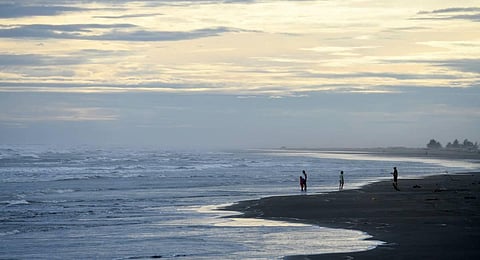

VISAKHAPATNAM: In a groundbreaking study, the scientists of the National Centre for Polar and Ocean Research in Goa found that the sea surged by over 100m off the Visakhapatnam coast over a period of 18,000 years. The research—Imprints of post-glacial sea level changes in the Visakhapatnam Bay (VB) basin: First documentation from multi-beam bathymetry data—published in the scientific journal ‘Geo-Marine Letters’, provides valuable insights into the region’s geological history.
The study was conducted by researchers Susanth S, Tyson Sebastian, and Mohammed Shafeeq under the supervision of Dr. John Kurian, group director of Deep Sea Exploration. “Over a period of approximately 7,000 years, sea levels have gradually increased, ultimately reaching their present day levels. It is crucial to acknowledge that rising sea levels are primarily linked to global warming and its associated consequences,” said the study’s lead author, Susanth S.
The research identified two undersea landforms at 90m and 105m respectively, which resemble old shorelines, indicating significant fluctuations in the sea level. “The first shoreline observed at 90m appears as a steep ridge standing 5m to 8m tall, resembling wave-cut terraces and cliffs formed when the sea level started rising after the glaciers melted,” the study said. The second shoreline at 105m has a gentler slope and is less distinct, suggesting a period of lower sea levels.
The researchers discovered irregular mounds between 90m and 100m, which are believed to be ancient barriers formed during a slow rise in sea level after the melting of the glaciers. “These barriers mark a transitional phase in the process of rise in the sea level. Studying palaeoshoreline features, including beach ridges, coastal terraces, and fossil coral reefs, are crucial for understanding the changes in the sea level,” the scientist pointed out.
Plan to map AP, Odisha coastal areas
Susanth emphasised the importance of these findings, stating, “As the climate warms and ice melts, sea levels rise. Studying the timing and rate of change in the sea level through these features enhances our understanding of climate dynamics, while fossilised marine organisms provide insights into past environmental conditions.”
The study also revealed that the linear trending features in the region are rich in fossilised corals, indicating the presence of relict carbonates with high calcium carbonate (CaCO3) content. These features provide valuable habitats for coral reefs and support diverse bottom-dwelling communities such as algae, fishes, and sea sponges.
Disclosing plans for future studies, Dr. John Kurian elaborated, “The linear trending features, which are variably spread across the shelf of Andhra Pradesh and Odisha coast, can provide valuable information about past hydrodynamic and sedimentation regimes, sea-level changes, and depositional centres. We aim to map the Andhra Pradesh and Odisha coastal regions in our future surveys, which could cover approximately 15,000 sq.km.”